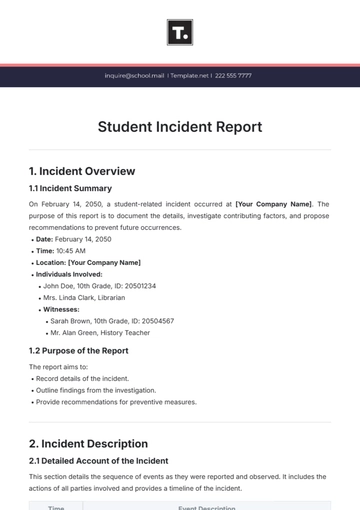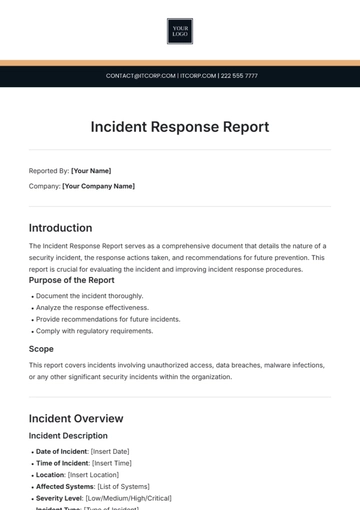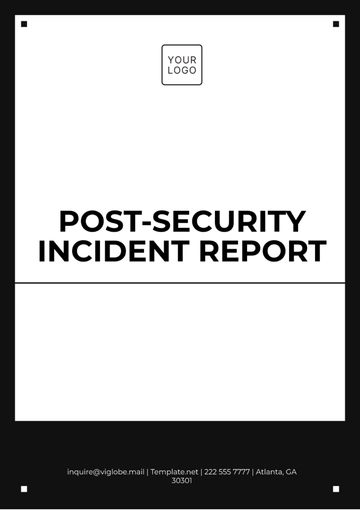Free Workplace Incident Investigation Report

Prepared by: [Your Name]
Position: Safety Officer
Date: October 5, 2050
I. Introduction
This report details the investigation of a workplace incident that occurred at [Your Company Name]. The primary objective of this report is to establish the facts surrounding the incident, identify root causes, and recommend corrective actions to prevent future occurrences. Ensuring a safe work environment is critical for maintaining employee well-being and productivity, and this investigation aims to enhance safety protocols across the organization.
II. Incident Overview
A. Incident Description
On October 3, 2050, at approximately 10:30 AM, an employee in the manufacturing department sustained an injury due to a malfunctioning piece of equipment. The incident involved a hydraulic press that failed to engage its safety guard, leading to the employee sustaining a sprained ankle. Following the incident, immediate first aid was administered, and the injured employee was subsequently transported to a nearby medical facility for further evaluation and treatment.
B. Incident Location
The incident occurred on the production floor, specifically near the assembly line, where various heavy machinery operates continuously. This area is integral to the manufacturing process and is subject to strict safety protocols. At the time of the incident, the hydraulic press was actively being used for routine tasks, highlighting the importance of ensuring equipment reliability and operator safety.
C. Witnesses
Several employees were present at the time of the incident and provided witness statements, contributing to a comprehensive understanding of the events leading up to the incident:
Jane Doe: Assembly Line Worker
John Smith: Supervisor
Alice Johnson: Maintenance Technician
Each witness provided insights regarding the circumstances surrounding the incident, including observations on the equipment's condition and the employee's actions just before the injury occurred.
III. Investigation Details
A. Evidence Collection
Physical Evidence: The hydraulic press involved in the incident was thoroughly inspected following the event. Maintenance records were reviewed to identify any previous service history or documented issues. The area surrounding the press was secured to preserve evidence and ensure no additional factors influenced the incident.
Witness Statements: Statements were collected from all witnesses present during the incident. Each account was documented and analyzed to identify common themes and discrepancies that could provide insights into the incident.
Surveillance Footage: Footage from the surveillance camera installed on the production floor was reviewed. This footage helped corroborate witness statements and provided additional context regarding the sequence of events leading up to and during the incident.
B. Findings
Equipment Malfunction: The investigation revealed that the hydraulic press was equipped with a malfunctioning safety guard, which failed to engage properly during operation. This critical failure directly contributed to the employee's injury.
Training Deficiencies: It was identified that the injured employee had not received adequate training on the safe operation of the hydraulic press. The lack of training highlights a gap in the organization's safety protocols and onboarding processes for machinery operations.
Maintenance Lapses: A review of the maintenance records indicated that the hydraulic press had not been serviced according to the recommended schedule. Regular maintenance is crucial for ensuring equipment reliability and safety, and lapses in this area can lead to increased risk for operators.
IV. Conclusion and Recommendations
A. Root Cause Analysis
The primary root causes of the incident were identified as a combination of equipment malfunction, insufficient training, and lapses in maintenance. Addressing these root causes is essential for preventing similar incidents in the future and fostering a safer workplace environment.
B. Corrective Actions
The following corrective actions are recommended to mitigate future risks:
Immediate Repair and Safety Checks: Conduct urgent repairs on the hydraulic press, including replacing the malfunctioning safety guard. A comprehensive safety check should be performed on all equipment to ensure reliability.
Enhanced Training Programs: Develop and implement comprehensive training programs for all employees on the safe operation of machinery and safety protocols. Regular refresher courses should also be scheduled to reinforce safe practices.
Strict Adherence to Maintenance Schedules: Establish a stringent maintenance schedule for all machinery and equipment, ensuring that all maintenance is documented and performed promptly. Regular audits should be conducted to ensure compliance with maintenance protocols.
C. Implementation Plan
Action | Responsible Parties | Timeline | Status |
|---|---|---|---|
Repair Hydraulic Press | Maintenance Team | By October 10, 2050 | In Progress |
Conduct Safety Training | HR Department | By November 1, 2050 | Planned |
Update Maintenance Schedule | Operations Manager | Immediate | Ongoing |
V. Appendices
A. Witness Statements
Enclosed are the detailed witness statements collected during the investigation, documenting each witness's account of the incident.
B. Surveillance Footage Analysis
Enclosed is the analysis of the surveillance footage, detailing the sequence of events leading up to and during the incident, highlighting critical moments that contributed to the injury.
C. Maintenance Records
Attached are the maintenance records for the hydraulic press involved in the incident, providing insights into service history and identifying any discrepancies related to scheduled maintenance.
- 100% Customizable, free editor
- Access 1 Million+ Templates, photo’s & graphics
- Download or share as a template
- Click and replace photos, graphics, text, backgrounds
- Resize, crop, AI write & more
- Access advanced editor
Enhance your workplace safety protocols with the Workplace Incident Investigation Report Template from Template.net. This editable and customizable template is designed to streamline the incident reporting process, ensuring all critical details are captured effectively. With clearly defined sections for incident description, analysis, and recommendations, it helps you maintain compliance and improve safety measures. Create professional reports that promote accountability and transparency in your organization with ease.
You may also like
- Sales Report
- Daily Report
- Project Report
- Business Report
- Weekly Report
- Incident Report
- Annual Report
- Report Layout
- Report Design
- Progress Report
- Marketing Report
- Company Report
- Monthly Report
- Audit Report
- Status Report
- School Report
- Reports Hr
- Management Report
- Project Status Report
- Handover Report
- Health And Safety Report
- Restaurant Report
- Construction Report
- Research Report
- Evaluation Report
- Investigation Report
- Employee Report
- Advertising Report
- Weekly Status Report
- Project Management Report
- Finance Report
- Service Report
- Technical Report
- Meeting Report
- Quarterly Report
- Inspection Report
- Medical Report
- Test Report
- Summary Report
- Inventory Report
- Valuation Report
- Operations Report
- Payroll Report
- Training Report
- Job Report
- Case Report
- Performance Report
- Board Report
- Internal Audit Report
- Student Report
- Monthly Management Report
- Small Business Report
- Accident Report
- Call Center Report
- Activity Report
- IT and Software Report
- Internship Report
- Visit Report
- Product Report
- Book Report
- Property Report
- Recruitment Report
- University Report
- Event Report
- SEO Report
- Conference Report
- Narrative Report
- Nursing Home Report
- Preschool Report
- Call Report
- Customer Report
- Employee Incident Report
- Accomplishment Report
- Social Media Report
- Work From Home Report
- Security Report
- Damage Report
- Quality Report
- Internal Report
- Nurse Report
- Real Estate Report
- Hotel Report
- Equipment Report
- Credit Report
- Field Report
- Non Profit Report
- Maintenance Report
- News Report
- Survey Report
- Executive Report
- Law Firm Report
- Advertising Agency Report
- Interior Design Report
- Travel Agency Report
- Stock Report
- Salon Report
- Bug Report
- Workplace Report
- Action Report
- Investor Report
- Cleaning Services Report
- Consulting Report
- Freelancer Report
- Site Visit Report
- Trip Report
- Classroom Observation Report
- Vehicle Report
- Final Report
- Software Report





























